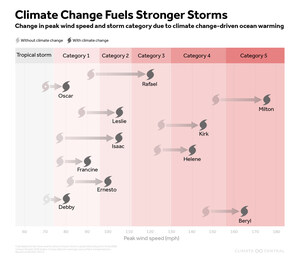Analysis of urban heat islands identifies neighborhoods that expose 41 million residents to significantly higher temperatures
Census tract-level data exploration of 44 U.S. cities finds more than ten-percent of Chicago, New York, San Francisco, and Washington residents experience temperatures elevated by at least ten degrees Fahrenheit because of localized environmental factors
PRINCETON, N.J., July 26, 2023 /PRNewswire/ -- As global temperatures climb, environmental factors in some city neighborhoods amplify heat even further, creating urban heat islands. A new Climate Central analysis of census tract-level data for 44 U.S. cities found that the urban heat island effect elevates local temperatures by at least eight degrees Fahrenheit in areas where 41 million people live, exposing residents to higher risks of heat-related illness and higher cooling costs.
Nine cities are home to at least one million people in urban heat islands where temperatures are elevated by at least eight degrees: New York (7.1 million), Houston (4.3 million), Los Angeles (3.3 million), Dallas (2.2 million), Chicago (2.1 million), San Antonio (1.5 million), San Diego (1.4 million), Phoenix (1.3 million), and Detroit (1.0 million).
The urban heat island effect exposes more than 70% of residents to at least eight-degree temperature elevations in Detroit (86%), New York (78%), Dallas (75%), New Orleans (74%), and Houston (73%).
In some neighborhoods, the urban heat island effect boosts temperatures by ten degrees Fahrenheit or more, impacting more than ten-percent of residents in Chicago, New York City, San Francisco, and Washington, DC. (Nearly 3.8 million New Yorkers, or 41% of the city's population, experience temperatures elevated by at least ten degrees, attributable to local environmental factors.)
"People in urban heat islands experience the amplified effects of climate change, especially during summer heat streaks that force millions to face higher temperatures than their neighbors," Jen Brady, Climate Central senior data analyst said. "Changes to the built environment can cool these neighborhoods, but until global temperatures stop rising, city residents will face increasingly steeper challenges to stay safe during periods of extreme heat."
Temperatures in urban heat islands are influenced by localized environmental factors including albedo (the degree to which surfaces like roofs and roads reflect or absorb heat), the amount of permeable surfaces, tree cover and greenspaces, building heights and airflow, and population density–which influences the heat generated by human activities, such as running air conditioners. Climate Central assessed the influence of each of these factors on U.S. census tracts, based on reported land cover zones within each tract, to calculate the urban heat island effect on populations reported in the 2020 U.S. Census.
A summary findings with links to data and maps for all cities, as well as customizable KML mapping files are available at: https://www.climatecentral.org/climate-matters/urban-heat-islands-2023
About Climate Central
Climate Central is a non-advocacy, non-profit science and news organization providing authoritative information to help the public and policymakers make sound decisions about climate and energy.
SOURCE Climate Central

WANT YOUR COMPANY'S NEWS FEATURED ON PRNEWSWIRE.COM?
Newsrooms &
Influencers
Digital Media
Outlets
Journalists
Opted In





Share this article